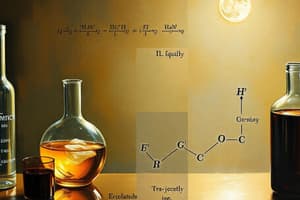Podcast
Questions and Answers
What is the primary purpose of balancing a chemical equation?
What is the primary purpose of balancing a chemical equation?
- To identify the limiting reagent
- To ensure the number of reactants is equal to the number of products
- To ensure the number of atoms of each element is the same on both reactant and product sides (correct)
- To determine the rate of the reaction
What is the role of the limiting reagent in a chemical reaction?
What is the role of the limiting reagent in a chemical reaction?
- It determines the amount of excess reagent left over
- It determines the type of reaction that occurs
- It determines the maximum amount of product that can be formed (correct)
- It determines the rate of the reaction
What is the correct format for writing a chemical equation?
What is the correct format for writing a chemical equation?
- Products + Reactants → Products
- Reactants → Products (correct)
- Products → Reactants
- Reactants + Products → Reactants
What is the term for the reactant that is not completely consumed during a chemical reaction?
What is the term for the reactant that is not completely consumed during a chemical reaction?
What is the purpose of calculating the mole ratios of reactants to products?
What is the purpose of calculating the mole ratios of reactants to products?
What is the result of balancing a chemical equation?
What is the result of balancing a chemical equation?
What is the first step in identifying the limiting reagent?
What is the first step in identifying the limiting reagent?
What is the relationship between the limiting reagent and the amount of product formed?
What is the relationship between the limiting reagent and the amount of product formed?
Flashcards are hidden until you start studying
Study Notes
Chemical Equations
- A chemical equation is a symbolic representation of a chemical reaction, where reactants are converted into products.
- Chemical equations are written in the format: reactants → products
- The reactants are the substances that are consumed or transformed during the reaction, while the products are the substances formed during the reaction.
- Chemical equations are balanced to ensure that the number of atoms of each element is the same on both the reactant and product sides.
- Balancing a chemical equation involves adjusting the coefficients (numbers in front of formulas of reactants or products) to ensure that the equation is balanced.
Limiting Reagents
- A limiting reagent is the reactant that is completely consumed during a chemical reaction, limiting the amount of product that can be formed.
- The limiting reagent determines the maximum amount of product that can be formed.
- Identifying the limiting reagent is crucial in stoichiometry, as it allows us to calculate the maximum amount of product that can be formed.
- Steps to identify the limiting reagent:
- Write the balanced chemical equation.
- Calculate the number of moles of each reactant.
- Compare the mole ratios of the reactants to the mole ratios of the products.
- The reactant with the smallest mole ratio is the limiting reagent.
- The excess reagent is the reactant that is not completely consumed during the reaction.
- The amount of excess reagent left over after the reaction is complete can be calculated by subtracting the amount of limiting reagent from the initial amount of excess reagent.
Chemical Equations
- Chemical equations are a symbolic representation of a chemical reaction, where reactants are converted into products.
- The format of a chemical equation is: reactants → products.
- Reactants are substances consumed or transformed during the reaction, while products are substances formed during the reaction.
- Chemical equations must be balanced to ensure the same number of atoms of each element on both reactant and product sides.
- Balancing a chemical equation involves adjusting coefficients to ensure the equation is balanced.
Limiting Reagents
- A limiting reagent is the reactant completely consumed during a chemical reaction, limiting the amount of product formed.
- The limiting reagent determines the maximum amount of product that can be formed.
- Identifying the limiting reagent is crucial in stoichiometry to calculate the maximum amount of product that can be formed.
- Steps to identify the limiting reagent include:
- Writing the balanced chemical equation
- Calculating the number of moles of each reactant
- Comparing the mole ratios of reactants to mole ratios of products
- The reactant with the smallest mole ratio is the limiting reagent
- The excess reagent is the reactant not completely consumed during the reaction.
- The amount of excess reagent left over after the reaction is complete can be calculated by subtracting the amount of limiting reagent from the initial amount of excess reagent.
Studying That Suits You
Use AI to generate personalized quizzes and flashcards to suit your learning preferences.




